

Introduction to Artbank
Artbank is a unique Government artist support and access initiative. For over 40 years we have supported thousands of Australian artists, building an impressive collection of over 10,000 artworks. Artbank artworks enrich government, business and residential spaces, exposing a wide variety of people to contemporary Australian art.
The Artbank collection was founded with an endowment of 600 artworks from the National Collection (now the National Gallery of Australia) and has since grown to include more than 10,000 works spanning media including painting, sculpture, video and photography.
Through leasing works to individuals, companies and governments, Artbank lives up to its policy principle of promoting broad access to Australian contemporary art. Through our leasing of artworks to Australian embassies and overseas posts, we provide access to Australian contemporary art in approximately 70 countries across the globe.
Artbank has similarities with other collecting institutions in how we undertake aspects of the business, but we are very different in both why we collect artwork and how we promote Australian art to stakeholders, clients and the public. For the broader community, we make Australian contemporary art accessible in ways other collecting institutions cannot.
With Artbank artworks in workplaces and other public and private places around Australia and the world, we enable the broader community to access some of the best examples of Australian contemporary art.
This allows for a different, more everyday type of engagement with artworks than a gallery or museum exhibition offers. By displaying works in offices, government buildings and homes, we present artworks to many who would never visit a public or private gallery, breaking down traditional barriers to this art form.
Browse our collection
artbank.gov.au
@instagram.com/ artbankau facebook.com/ ArtbankArt
Subscribe to eNews: artbank.gov.au/ about-artbank
Artbank Sydney, photo Tom FergusonRobert FIELDING
Kunkarangkanypa

Tjukurpa - Seven Sisters, 2011
Painting
Synthetic polymer paint on canvas #13306
Robert Fielding (b 1969) is considered one of Australia's leading Indigenous artists. He works in a variety of media from photography and video to painting and sculpture. He has been shown in many important shows such as a monographic show at ACCA and The National. Based in Mimili in the Everard Rangers on the Anangu Pitjantjatjara Yankunytjatjara (APY) Lands in the north west of South Australia. This painting depicts the ancient Dreaming story of the seven sisters and wati (man), which refers to the constellation of stars also known as Pleiades and Orion. The story is sacred and only a small part can be told. Fielding states: "A long time ago, the seven sisters came down from the sky and walked on the earth. They travelled north from Port Augusta, a wati saw them and followed them... When the sisters would stop for a break the wati would watch them and decide which sister he liked the most."
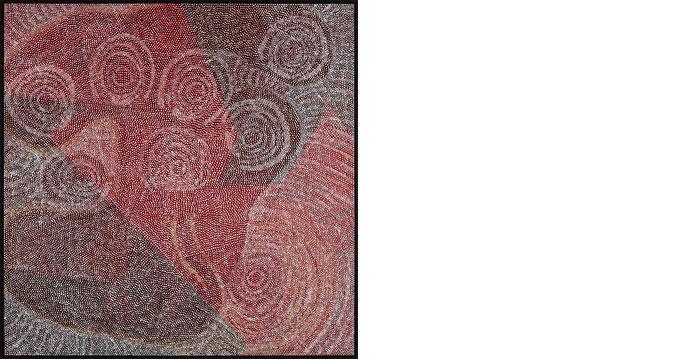
Tjaruwa WOODS

Kamanti, 2018
Painting
Synthetic polymer paint on canvas #15028
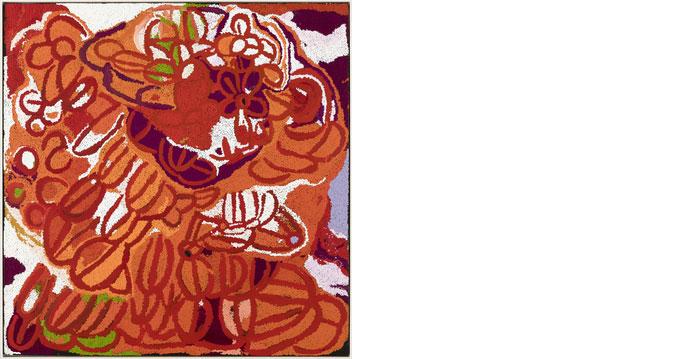
Tjaruwa Woods is an artist making paintings as well as weaving and carving. Woods was born at Warutjara near Jamieson in Ngaanyatjarra lands. She lived on country in the traditional manner until 1986, and later settled in Tjuntjuntjara. Woods’ art draws on her experiences living on country and on culture and designs passed to her from her mother. Her paintings feature incredibly vibrant and dynamic use of colour, particularly bright red and green. These fields of colour are created through a thick overlapping dotted technique. Woods has exhibited widely, and her work appears in important collections.
This painting is typical of Tjaruwa Wood’s style and captures the distinctive landscape of the sand dunes that make up much of her Country. In the work, shades of vibrant red interplay in a lively, lyrical composition. Bright white is used to capture the stark expanses of salt lakes and rich patches of green are applied sparingly across the canvas to represent pockets of fertile land. Whilst seemingly geographical, her work depicts the inextricable connection between landscape and the spiritual networks of the Tjukurpa.
Christopher HAMNETT
Untitled No. 2, 2012


Painting
Oil and synthetic polymer paint on canvas #13527
Christopher Hamnett is a Tasmania based artist who uses his experience of living with Obsessive Compulsive Disorder to develop his approach to abstract painting. Exploring his childhood compulsion to write numbers on paper for hours at a time, Hamnett uses the canvas as though it were a sheet of paper, sometimes aligning the numbers in a carefully ordered pattern and sometimes setting them adrift as the mind becomes absorbed in the task and "the rhythm loses step slightly".
GuidoMAESTRI
The Flood, 2021
Painting Oil on canvas
#16588

Maestri wrote of this work: This is a memory painting. Becoming a parent has made me reflect on my own childhood, and also consider the world we will leave to our kids. For a child growing up near a river, a flood is one of those markers in time. Your childhood timeline is punctuated with memories of these exciting and aweinspiring spectacles. Floods were a natural cyclical event. Unfortunately, floods now seem more about climate change than spectacle.
Guido Maestri (b. 1974, Mudgee) is known for his highly textural, expressive works that explore the painted materiality, gesture and observation. Although he is noted for his en plein air paintings and strong connection to the Australian landscape, Maestri also employs still-life and portraiture to investigate the conventions of painting. Maestri’s love affair with the Australian landscape has taken him across the mainland in search of new vistas to paint, covering areas including the Tanami Desert, Northern Territory; Western Volcanic Plains, Victoria; Mutawintji National Park, New South Wales; Hill End, a former gold mining town in New South Wales.
This is a very characteristic landscape for Guido Maestri. The work is painted in a few styles from expressive impressionism to stylised geometries of stripes and hard edges. This hybridity marks the painting as contemporary. In the centre of the painting on the diagonal is a painterly section, that cuts across the work, almost on another plane, which is the flood water cutting a swathe across the landscape.
This painting was a finalist in the Wynne Prize 2021. A similar work from the 2020 Wynne Prize was purchased by the Art Gallery of NSW in the same year. His works are collected widely, including institutions such as National Portrait Gallery (Australia), Art Gallery of New South Wales (Australia), Art Gallery of South Australia, and Fubon Art Foundation (Taiwan). He won the Archibald Prize in 2009.
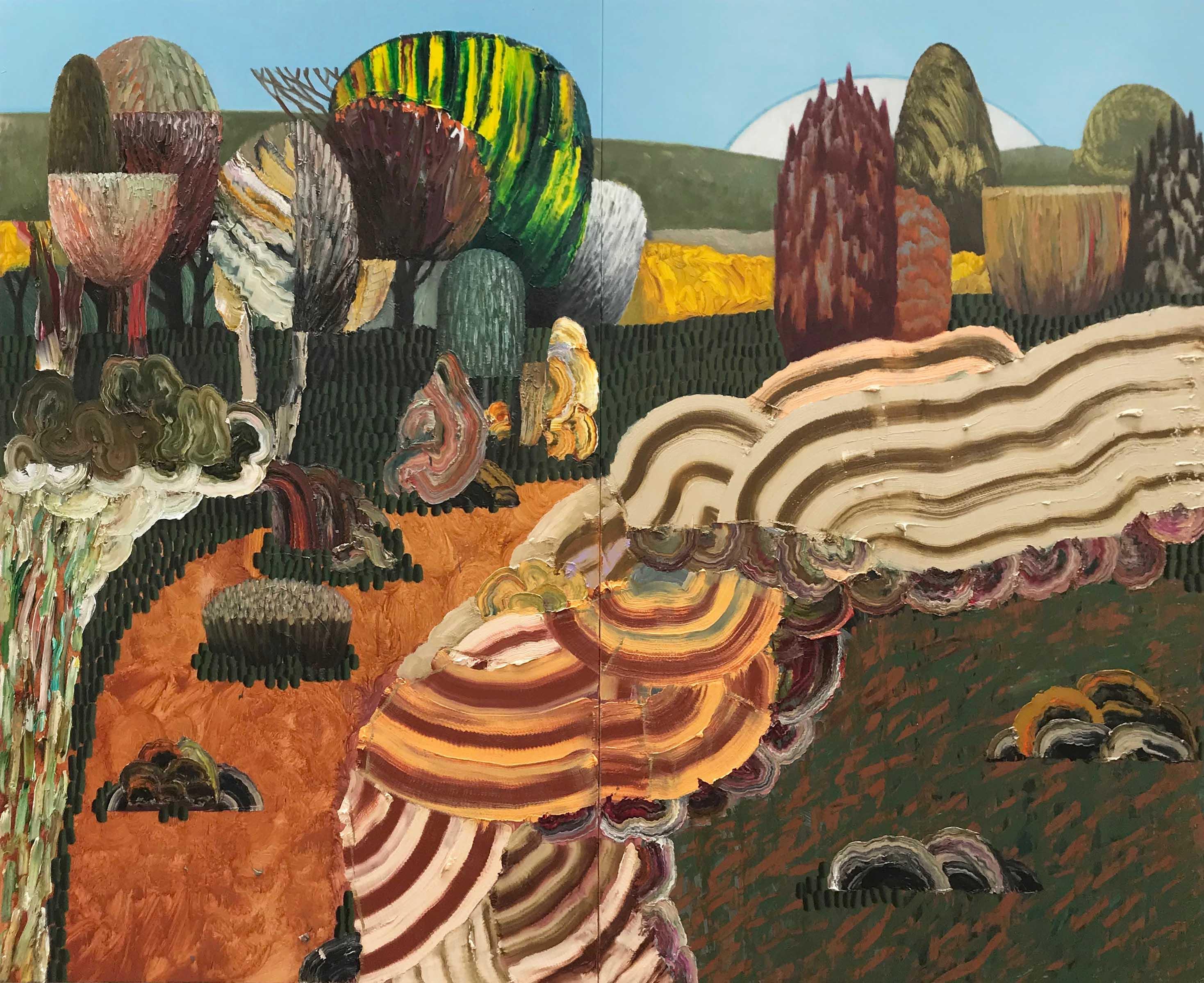
Emma SINGER
Ngayuku Ngura, 2022

Painting
Synthetic polymer paint on linen #16605
Emma Singer (b.1986) was born in Alice Springs and came back to Mimili soon after her birth. Emma has two brothers and a sister who also live on the APY Lands. Emma’s mother Pauline is one of the senior artists in Mimili. Emma is passionate about education and works part-time at the school to support the next generation of Anangu in Mimili. Emma is also the youngest director Mimili Maku Arts has ever had, and represents the young and emerging artists on the board.
Singer says of the work, "I don’t paint one specific storyline or site, but rather the many paths and journeys taken by my people, always following our storylines and movements of country. Some important elements in my paintings are the rock holes that carry fresh water, the waterways that connect them both above and below ground, the fields of spinifex that used to be everywhere, the campsites of my ancestors, and the paths they used to walk".

David McDiarmid
Disco Kwilt, c.1980
Drawing

Self-adhesive holographic film on composition board #13697
David McDiarmid's art reflects his role in the Gay Liberation movement of the late twentieth century in Sydney and in New York, where he lived and worked from 1977 to 1987. Soon after his arrival, McDiarmid described New York as "like going to school on a very high level; on an art level, a sex level-the two most important things. It was like a playground." 'Disco Kwilt' is from a series of holographic 'quilts' that capture the rich visual fodder of the drug fuelled, sexually charged queer party scene that captivated McDiarmid, particularly that of New York's legendary early dance club Paradise Garage (1977-87). The 'baby block' patterning is a reference to the popular historical quilting technique of American pioneer women, and is a characteristic example of McDiarmid's knowing manipulation of references to craft practices 'traditionally' associated with women's home-making. The celebratory nature of McDiarmid's disco quilts captures a sentiment right at end point of gay liberation before the eruption of the AIDS crisis.
Gift of Mr Bernard Fitzgerald 2013. Donated through the Australian Government's Cultural Gifts Program.

Jack BRITTEN
Hill Country Dreaming of Women from the Nangala Skin Group, 1992
Painting
Natural earth pigments and synthetic polymer binder on canvas
#7897
Jack Britten (b.1921 – d. 2002) was from the Tickelara region (South of Frog Hollow), of Frog Hollow (Woorreranginy) via Turkey Creek, Western Australia. He was of the language group Kiga and the skin name Joolama. He periodically worked as a stockman on cattle stations in the Kimberleys and when the Warmun Community was established at Turkey Creek in the mid-1970’s Jack Britten moved there with his family and began working to establish the Woorreranginy Outsation at Frog Hollow. Jack Britten began painting in the early 1980’s.
In the painting Hill Country Dreaming of Nangala Women Britten has recorded the hills of the Dreamtime of the women from the Nangala skin group. The hills and valleys are depicted in profile. The alternating rows of dots and lines echo the striated surfaces of the cliff-faces while also referring to ceremonial body designs. These hills called Karrakiny are the Dreamtime rocks of the women.
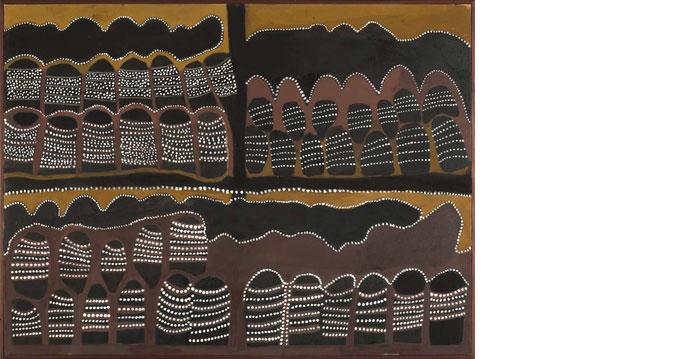
Britten’s work is held in many public and private collections including the National Gallery of Australia; the National Gallery of Victoria; the Art Gallery of Western Australia and the Wim Wenders Collection.

LenaNYADBI
Gudagudawoon, Lissadell Station, 1999
Painting
Natural ochre and pigments on canvas
#10421

Lena Nyadbi AO (born c. 1936, near Warnmarnjulugun lagoon, Western Australia) is a contemporary Indigenous Australian artist from the Warmun Community in the Kimberley region of Western Australia. In 1998 Nyadbi began painting full-time. In 2006, Lena was one of eight Indigenous artists from Australia featured in the Musée du Quai Branly project in Paris.
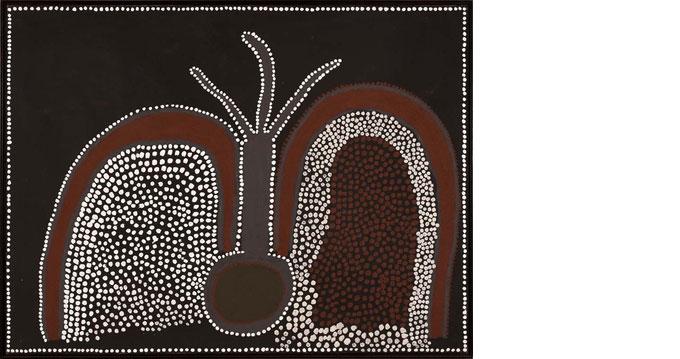
Lena paints two principal Dreamings; Jimbirla and Dayiwool Lirlmim. Jimbirla are the sharp quartz-like stones used by Gija people in the past to make spear tips. These are found in abundance in Nyadbi’s father’s country, which lies to the north of Warmun. Dayiwool Lirlmim are the scales that scraped off the Ngarranggarni (Dreaming) barramundi as she jumped through a range of hills escaping from the spinifex nets of women who were trying to catch her.
Nyadbi is represented in a number of collections including the National Gallery of Australia, Canberra; National Gallery of Victoria, Melbourne; Art Gallery of South Australia, Adelaide; Art Gallery of Western Australia, Perth; Museum and Art Gallery of the Northern Territory, Darwin; Kerry Stokes Collection, PerthLatrobe University, Victoria; National Australia Bank, Melbourne; Western Mining Corporation Collection, Perth and private collections.
VernonAH KEE
see me, 2006
Painting
Synthetic polymer paint, charcoal and crayon on canvas
#11816

An active a member of the urban Aboriginal artist collective ProppaNow, Brisbane based artist, Vernon Ah Kee (b.1967) is of the Kuku Yalandji, Waanji, Yidindji, Gugu Yimithirr and Koko Berrin peoples from Palm Island. Primarily a painter, Ah Kee works across a range of mediums to engage in a critique of Australian culture and in particular the historical and current treatment of Australian Indigenous people. His work is often underpinned by highly personal sentiment.
"see me" is a work that challenges the legacy of Norman Tindale's 1938 anthropological expedition to Aboriginal communities, and the numerous anthropological photographs he took For Ah Kee the photographs represent the colonising gaze, pinning the Aboriginal subject like a scientific specimen. Ah Kee's grandfather and great grandfather were among the people photographed. This work reclaims Tindale's research and reframes it as a celebration of family and resilience. The first two panels of the work depict Vernon's grandfather, Mick Miller, a noted boxer. Images of Ah Kee's grandfather are from the Tindale Collection. The third panel is of Vernon's son who moves boldly forward in the picture plane meeting the future head on Ah Kee finds power and humanity through reclaiming the portraits and returning the gaze.
Vernon has represented Australia at the 2009 Venice Biennale . He’s featured in group exhibitions such as Revolutions – Forms That Turn: 2008 Biennale of Sydney and Culture Warriors: National Indigenous Art Triennial at the National Gallery of Australia. Vernon features in the National Gallery of Canada, the Hood Museum of Art in New Hampshire, USA, and the Museum of Contemporary Art in Sydney. He was a 2012 Archibald Portrait Prize finalist for his portrait of Indigenous activist Lex Wotton.

Naminapu MAYMURU-WHITE
Milŋiyawuy River of Stars
6, 2021
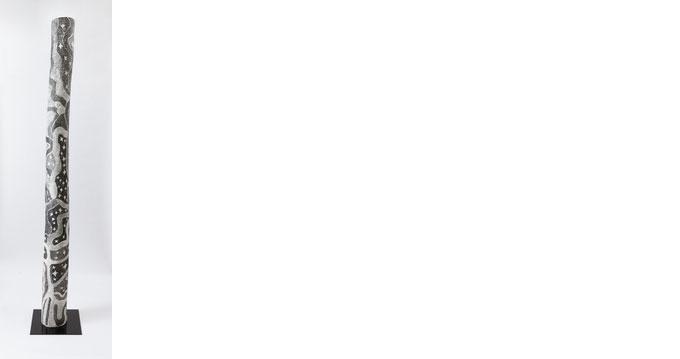

Sculpture
Earth pigment on wood
#16568
Naminapu Maymuru (b. 1952) was born a member of the Mangalili clan, at the Yirrkala mission station in Northeast Arnhem Land in Northern Australia. She married Leon White, a teacher in the Northern Territory, and Naminapu went to live off country for several years in Melbourne and Darwin. She travelled within Australia extensively as well as to Japan. In 1985, Naminapu returned with her husband and family to live in Yirrkala, now a locally governed Aboriginal community. Maymuru-White was one of the first Yolŋu women to be taught to paint miny’tji (sacred creation clan designs) but she is also known as a great innovator. She is also important as one of the first senior women to paint larrakitj.
This pole from the exhibition Milŋiyawuy—The River of Heaven and Earth tells ancestral stories from the Maŋgalili clan. Two Guwak men who drowned at sea and gave themselves as offerings to the night sky, where they and subsequent Maŋgalili souls are seen today in the Milky Way. The design is totally Naminapu’s, it flows and moves in dynamic curves. The design represents both the sea and water (an important motif of Yolngu art) and the mist of a galaxy of stars.
Across an extended career, Naminapu has exhibited widely and won numerous awards, including two Telstra National Aboriginal and Torres Strait Islander Art Awards: one in 1996 for her lino print triptych Nyapilingu; and the other in 2005 for one of her larrakitj. The larrakitj with the Milŋiyawuy or milky way design, like this one, won the Wandjuk Marika Memorial 3D award. A similar design was the centrepiece, floor work in the foyer of the NGV, for the Bark Ladies exhibition, 2021.
Katarina VESTERBERG
Passage #1, 2005

Painting Oil on Belgian linen #11680
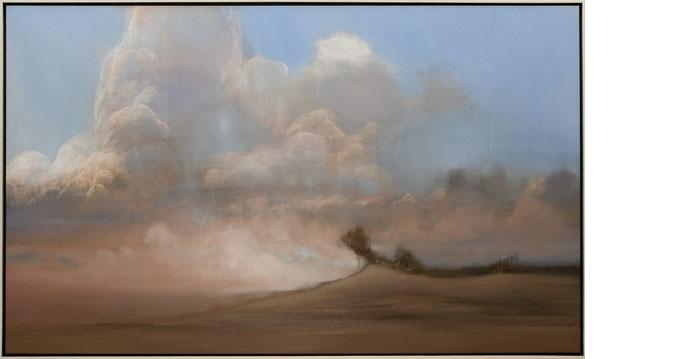
Katarina Vesterberg (b. 1962, Karlstad, Sweden; migrated to Australia in 1971) lives on the outskirts of Brisbane. Vesterberg has spoken of feeling like a stranger in a strange land in her native Sweden; in Finland - her mother is Finnish - and in Australia, her adopted country. Like many migrants, Vesterberg believes she may never feel truly at home.
Even though today her main inspiration resides in the geographical and biological diversity of the mudflats and sand islands that form the perimeter of Queensland's Moreton Bay, Vesterberg's paintings of vast, windblown spaces continue to evoke a sense of the Romantic sublime. Through the observation of nature, she explores the spirit of the world and the meaning of existence.
Dorothy NAPANGARDI

Karntakurlangu JukurrpaSalt on the Mina Mina, 2002
Painting
Synthetic polymer paint on canvas #10986
Indigenous artists often paint country as a way of establishing ownership to that place, of narrating important stories located there, and as a way of manifesting connection to protocols, law and spituality through the country depicted. Dorothy Napangardi, a Warlpiri artist born at Yuendumu in the Tanami desert in the Northern Territory has painted her custodial country near Lake Mckay, north of Yuendumu. It is a place made up water soakages that exist as claypans, where small areas of the earth dry out and lift at the edges, becoming delineated by salt; the dotted design graphically illustrating this. This women’s area, where Napangardi and Napanangka groups gathered to collect karlangu (digging sticks) is a hugely significant site, and one that the artist has recreated endlessly to reaffirm the constancy of connection to her land, where the Yuendumu exist at the centre of this world.
 Clothilde Bullen
Clothilde Bullen
Rod McRAE
Murmer, 1994
Painting Oil on canvas #8888
Rod McRae (b. 1950 Norwich, England, arr. Australia 1982) has had a diverse artistic output. In the early 1980’s he worked as a children’s book illustrator/author, producing over 50 books. In 1984 he joined Bruce Pollard’s Pinacotheca Gallery in Richmond. McRae in general plays with a form of surrealist landscape and figure. It is broadly a British form of surrealism that focuses on the real made strange. McRae’s first exhibition at Pinacotheca was of paintings of mythological figures set in a fantastic landscape which were likened to the painting of James Gleeson. From 1989 his work became more abstract with organic, more akin to Tanguy or Georgia O’Keefe.
Murmur comes from the early style of surrealist imagery. The work seems to be a form of broken body as landscape, with a large head to the left. The colour palette is a pink and grey and off key and the body parts fuse into a rocky landscape which is rhythmic and controlled. This tension between the real and the artificial, the body and the rock, the natural and the fantastical, the landscape and the dream is what makes this picture function.

He has been a finalist twice in the Blake Prize for Religious Art (2005 and 2006) and a finalist in the Wynne Prize for Australian landscape/figurative sculpture in 2007 and 2010.

Robert DICKERSON
Street Corner, c. 1956
Painting Oil on board #1667
Robert Dickerson (1924– 2015) is one of Australia’s most recognised figurative painters, often portraying the emotions of isolation and loneliness in his work. Dickerson’s interest in the figurative came from a desire to paint honest, socially realistic works of people and situations from everyday life.
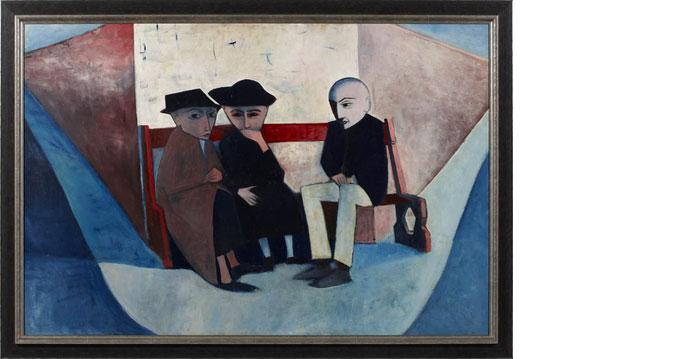
In Street Corner figures sit alienated from each other and their featureless environment. The sparse setting directs the focus onto their faces and their penetrating almond shaped eyes. Dickerson says, “I find beauty in working people…Their eyes say something and I like to get this into my painting”.
His work is now held in numerous public collections in Australia including the Art Gallery of New South Wales, National Gallery of Victoria, National Gallery of Australia and Queensland Art Gallery of Modern Art.

Kirstin BERG
Precipice 1, 2011
Drawing Graphite, ash, watercolour pigment and pins on paper #13084
Kirstin Berg (b. 1973, Beechworth, Victoria) is a paper-based artist whose practice is concerned with themes of environmental and humanitarian crisis. Her constructions combine unconventional materials such as fire ash, bush debris and hard rubbish into epic wall works and sculptural ephemera.

In ‘Precipice 1’ Berg brings a new element to her work, incorporating washes of colour in to her backdrops. The sweeping gestures force the audience to question the solidity of the ground on which they stand, sending us in a spin across a boundless sky. By arranging pieces of torn and folded paper, Berg attempts to create order amongst chaos in an uncertain world.
Berg has exhibited extensively in Australia and internationally with her work being held in major collections such as the NGV, Parliament House Art Collection and private collections in Australia, Europe and the USA.

Birmuyingathi Maali
Netta LOOGATHA
Makarrki, 2013
Painting
Synthetic polymer paint on canvas
#13818

Birmuyingathi Maali Netta Loogatha (b. 1942) was born at Bilmee on Bentinck Island in the Gulf of Carpentaria, off the coast of Queensland. She lived a traditional life until 1946 when she and her family were moved to the mission settlement on nearby Mornington Island. Loogatha is a Kaiadilt woman and is part of a group of senior female painters known as the Bentinck Island Artists. They began painting in 2006 after Sally Gabori became involved in painting workshops to encourage the telling of stories through art.
Loogatha's paintings often conceptualise the complex interplay of cosmological forces that have created a story place on her Country. Her vibrant paintings reflect the topography and cultural traditions of her ancestral homeland. This painting shows Makarri, a large river system on Bentinck Island where her father was born.
Loogatha’s work has been shown in many exhibitions across the country. She has been a finalist in a number of awards including the 24th National Aboriginal and Torres Strait Islander Art Award. Her work is held in a number of public and private collections including National Gallery of Victoria, Queensland Art Gallery and UQ Art Museum.
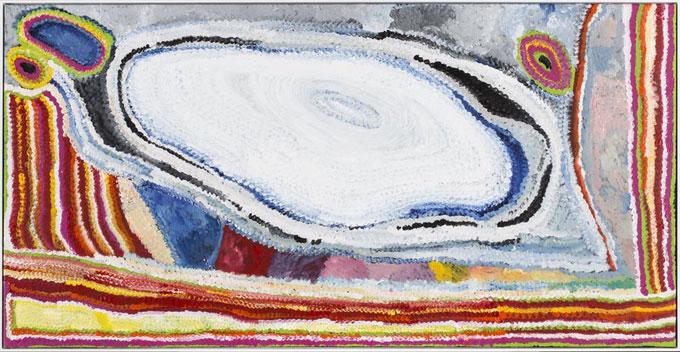
Simon HOGAN
Lingka, 2015

Painting
Synthetic polymer paint on canvas #14534
Simon Hogan is a Pitjantjatjara man born around 1930 between Paltju and Lingka in the Spinifex Lands of the Great Sandy Desert in Western Australia. He is a senior traditional owner of Spinifex Country who played an instrumental role in the Spinifex country Native Title claims in 2000 and is a highly regarded painter who works at the Spinifex Arts Project – an Indigenous owned and run centre that also emerged out of the 2000 Native Title claim, as a way for the community to document their knowledge and right to country. This painting is a sophisticated example of Hogan's knowledge of country and Tjukurpa (creation stories), depicting Lingka – the site of the creation stories of the Wedge Tail Eagle and the Crow. Here Hogan has represented the mulga trees of the region and the waterholes in high keyed colour and patterning. Many of the creation stories Hogan works with are secret and sacred to those who are initiated, and accordingly Hogan paints only sections of the stories that are allowed to be publically discussed.

WATARRU COLLABORATIVE

Beryl JIMMY
Imitjala POLLARD
Kunmanara (Wipana)
JIMMY
Kuka Mamu, 2018
Painting
Synthetic polymer paint on canvas #15067
‘Kuka Mamu’ is a painting by the Watarru Collaborative, consisting of senior women Kunmanara (Wimpana) Jimmy and her daughters Beryl Jimmy and Imitjala Pollard working from the Nyarpari community in the APY Lands.
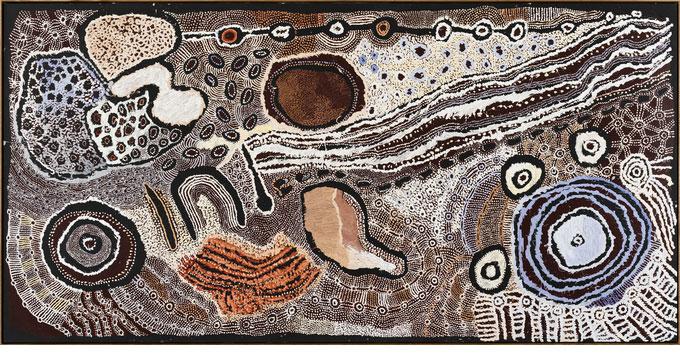
Nyangatja Tjukurpa Watarru-ku mantangka Watarrula ngarantja, Wati Mamu tjukurpa (Tjukurpa Wati pikati-tjara). Paluru ngurangka nyinangi kuka winki-tjara, paluru kuka palyara tjunkula wanting.
This is the story for Watarru area about the Wati Mamu (the harmful spirit being). He is sitting with the meat he has collected. He has chopped it up into small pieces.
‘Ka ngayulu painting nyanga palunya nyakula kulini panya ngayuku ngunytjungkulanya wantikatingu nganananya malanypa ngayuku kulu.’
‘When I look at this painting I see my mother saying goodbye to me and my sister’ – Imitjala Pollard
TJUNGU PALYA PRINT SERIES
2009 Print Screenprint #12597
In 2008, the artists of Tjungu Palya art centre at Nyapari decided to produce a series of silkscreen prints of the traditional dreamings of each artist. Master printmaker Basil Hall was invited to Nyapari to work with the artists, and on his return to Darwin printed 40 sets of the 10 prints at Basil Hall Editions.
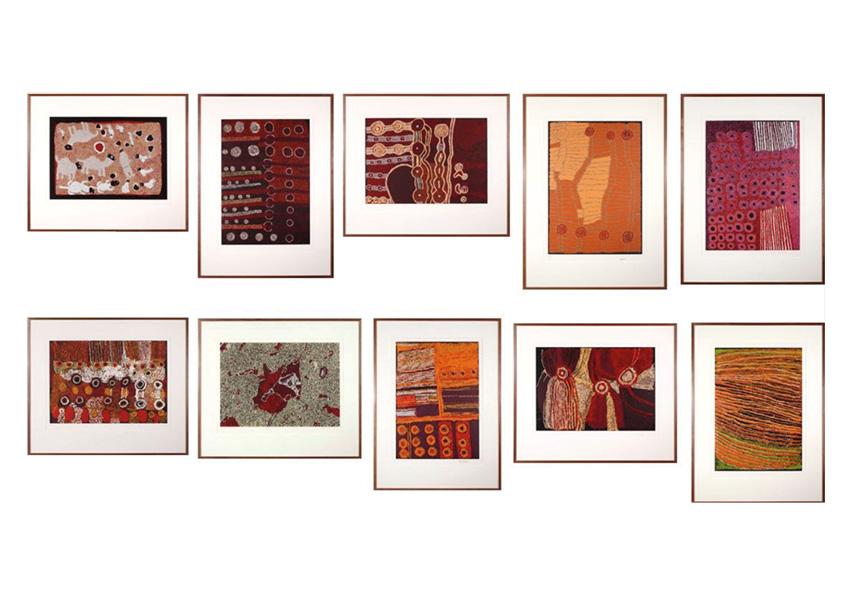
The artists involved included senior artists such as Jimmy Baker, Nyankulya Watson, Bernard Tjalkuri, Ginger Wikilyiri and Wingu Tingima, and emerging – but not necessarily young – artists such as David Miller, Beryl Jimmy, Angkaliya Curtis and Lance Peck. At the time the community manager was Amanda Dent. The community is made from three traditional groups all represented by different dreaming stories. Each of these prints represents a major motif in the artists practice which can be seen in their more major works. Beryl Jimmy for example has represented the Watarru Story which is also the subject of the large painting on the other side of the hall. Each artist has their own style and approach and a series such as this, that within traditional story telling, the innovation and energy of Tjungu Palya is extraordinary.
Tjungu Palya The series was exhibited widely at the galleries that represented Tjungu Palya, including Vivien Anderson Gallery, Melbourne, Marshall Arts, Adelaide and Randall Lane Gallery, Perth.

Noᶇgirrᶇa MARAWILI Baratjala, 2019
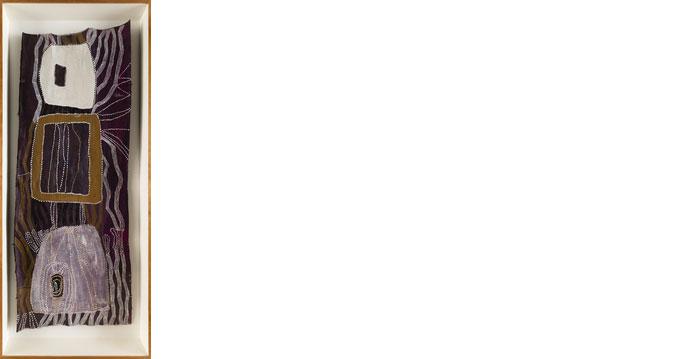
Painting
Earth pigments, print toner on bark #15287
Nongirrna Marawili (Madarrpa, b. 1939, North East Arnhem Land) is one of the senior painters working at Yirrkala. Marawili began painting in earnest in 2011, after work as a printmaker, and her first solo show was in 2013. Prior to this show some of her major paintings were in collaboration with her husband, Djapu elder Djutjadjutja Munungurr. After Munungurr passed away Nongirrna continued to paint Djapu themes More recently Nongirrna has begun painting Madarppa forms, authorised by her relationship to her father, Mundukul (Lightning Snake), a pre-contact warrior and painter.
Her work is innovative and expressive. Marawili describes her lightning works as “meaningless” (mayilimiriw). They are not intended as story paintings. However curator Judith Ryan suggests, “Although Nonggirrnga disavows any sacred intent, her Madarrpa identity underlies her practice, and therefore the echo of miny’tji.” Nongirrna is equally revolutionary in relation to material. She mixes ochre and natural material with the magenta ink of discarded ink cartridges (which as they are found “on the land” are allowed to be used).
Although Nongirrna asserts that these works are meaningless, or in other words, not sacred, Baratjala is in sacred law the site of the Lightning Snake, Mundukul. Cara Pinchbeck, describes her work as representing “the spirit and energy of a life lived on country”. The waters of Baratjala are treacherous and awe inspiring with strong tides, crocodiles and cyclones, white sea spray and electricity. This work captures that drama and tragedy. The rocks, solid and unmoved, represent the stoicism and vitality of Madarrpa culture.

Rover THOMAS
Jaandoo (Wild dog dreaming), 1995
Painting
Pigment on canvas #9075
Rover Thomas (1926- 1998) is one of Australia’s most important Indigenous artists. Born on the Canning Stock route Thomas grew up working on cattle stations and began to paint in the late 1970s after a visit from the spirit of a community member who had recently passed away, and who conveyed to him the stories of the ceremonial narrative dance cycle the Kuirr Kuirr. Thomas’s highly distinctive and individual approach is characterized by a rich and dense application of ochres and a spare yet striking use of dotting in his bold, abstracted responses to landscape and the histories played out on the land.

Wild Dog is a striking work from 1995, the year Rover Thomas took his first trip back to his birth lands in forty years.
In various renditions of the Wild Dog/Dingo Dreaming, Thomas paints the Dreaming place of the Mother Wild Dog linked to its babas or ‘puppy dogs’ by subterranean passages (not depicted). Also sometimes depicted are rockholes atop ridges, represented by small circles, which were vital sources of water, as well as important places in associated Dreamings.
The dog’s importance is also linked to the origin of Thomas’ European first name: Waringarri Arts has documented that when Thomas first came to the East Kimberley as a young man, his fondness for talking about his Dingo/Wild Dog Dreaming led to the local Kija people nicknaming him ‘Rover’.

Jubilee WOLMBY
Shark (Older Apalech Brother Markings), 2004
Sculpture
Natural earth pigments and synthetic polymer binder on milkwood
#11458

Jubilee Wolmby was born in 1949 and died in 2005. He, like his father, was from the Wik Ngathan language group (his father from the Apalech clan), while his mother was from the Kugo Mumanh language group of the Puch/Wannum clan.Wolmby lived at Aurukun on the Cape York Peninsula of far north Queensland.
His father's totem is the shark and this shark sculpture shows the markings of the older Apalech Brother. For the Apalech clan, the story of the Apalech Brothers is an important "creation story" and important law; it is a subject of many artists and is often revisited in Jubilee's work. The Apalech Brothers are attributed with making all the stories and songs for the area and its people, and were those who determined the paint for ceremonial objects and dancers.
Wolmby is represented in the collections of the National Maritime Museum, Sydney; National Museum of Australia, Canberra, and the Queensland Art Gallery, Brisbane.

Geoff NEWTON
Finger Painting, 2008
Painting
Synthetic polymer paint on canvas #12199
Geoff Newton (b. 1977) is a painter, curator, writer, musician and Co-Director of Melbourne’s Neon Parc gallery. He was previously the Director of Dudespace and is a current member of DAMP, a Melbourne based collective that was established in 1995 and has continued to present performances, exhibitions and events that attempt to confuse the relationship between artists and audiences.

Newton’s work came to maturity in the 90s when a certain post-conceptual and almost grunge aesthetic was common in painting. His work is intertextual, and fragmentary. Antoher aspect is the use of titles and other textual devices to conceptually contextualise the work.
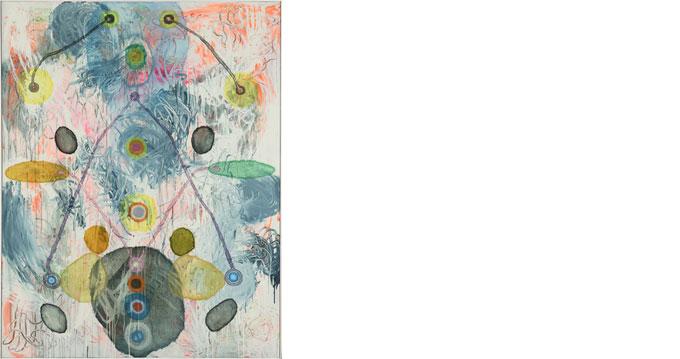
Finger Painting has prints and marks of the artist’s hand intermingled with brushstrokes. It is a conflation of high and low approaches to painting. The title is in this way a misnomer and the combination is although declassed, a knowing debasement of the craft of painting.
Robert Cook, Associate Curator of Contemporary Art at the Art Gallery of Western Australia points ot the sublte politics in Newtons work. He writes:
It sets up complicated traps, and instead of saying, think this, think that, my how the starving are suffering, etc, he wants us to figure out our own response like adults. This is what is hard, because it make us think about how our titles and positions and ignorances and educations affect the response. We don't want to do this. I don't. I want to remain in my fairy land of gentle happiness. And Geoff won't let this happen…
Sabo TIPILOURA
Bird Pole, c.1988

Sculpture
Natural earth pigments on ironbark #6623
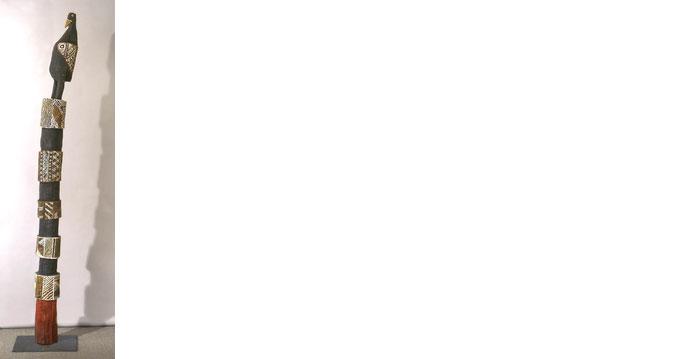
Sabo Tipiloura has been carving for about twenty years and is the last of the original group of prolific Tiwi Pima Art carvers on Bathurst Island, and through his work at the local school, Tipiloura has influenced a number of younger carvers.
'Bird Pole' alternates dark colour pigments with intricate geometric patterning - a distinctive feature of Tiwi art. The figure of a bird sits at the top of the pole. Sea birds such as pelicans are a recurring theme in Tiwi art. It is said that sea birds witnessed the first pukumani (funeral ceremonies) in the Tiwi and taught the first ritual dances.
Pedro WONAEAMIRRI
Tutini (Pukamani pole), 1995
Sculpture

Natural earth pigments on ironwood #9965
Pedro Dennis Wonaeamirri was born in 1974 at Pirlangimpi on Melville Island. His country is Goose Creek, Melville Island, his skin group Mulipurrula (White Cockatoo) and dance Jilarti (Brolga). A member of Jilamara Arts & Crafts Association since 1991, he lives and works at Milikapiti on Melville Island. Wonaeamirri works across various mediums including natural ochres on paper, linen and bark, print-making and carving. He was taught to carve by his uncle, the renowned Tiwi artist Romuald Puruntatameri.
This tutini (or Pukamani Pole) were originally used in funeral rites which also includes dance and song. Erected around the grave the poles were traditionally left to the elements to gradually return to the earth. The ochre designs on the poles mimic Tiwi face and body painting, also fundamental to the pukumani ceremony in camouflaging, and thus protecting, the dancers from the spirit of the deceased.
Held in major Australian collections, work by Won aeamirri is in international collections such as The British Museum, London and Kaplan & Levi Collection, Seattle, United States.

Bonaventure TIMAEPATUA
Pukamani Pole, n.d
Sculpture
Natural earth pigments on ironbark
#2397

Size (cm): 173h x 55w x 35d
Tiwi artist Bonaventure Timaepatua (1928-1982) was a carpenter, builder and fisherman before starting to carve and paint in 1978 He created many pukumani poles, as well as human and animal figures, working at the Tiwi Design art centre on Melville Island.
Amongst the Tiwi of Bathurst and Melville Islands the 'Pukumani' is a state of mourning imposed upon the kin of a deceased person, and the name of the funeral ceremony. However more than a burial ceremony, Pukumani describes an extraordinary state of being which affects all those connected with the deceased. It includes prohibitions concerning the interaction of certain categories of kin and the touching of particular objects and food, and demands a particular style of behaviour to be followed by the mourners in daily life. Pukumani is lifted when the long sequence of ritual is ended.
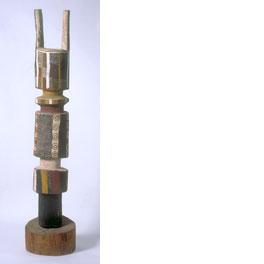
Nellie NAMBAYANA
SallyGARROMARA
Miranda BAKER
Fish Trap, 2005
Sculpture
Pandanus
#11509, #11508, #11547

Nellie Nambayana, Sally Garromara and Miranda Baker are from the Maningrida community in East Central Arnhem Land and from the Burarra language group. Located on the coast of the Arafura Sea, this region is known for conical fish traps, and traditionally these were crafted by men and used for hunting and ceremonial purposes.
Burarra and Kuninjku people are particularly renowned for making fish traps. Burarra make conical fish traps called jina-bakara, using pandanus grass (Pandanus spiralis). The Kuninjku people traditionally make two sorts of conical fish traps, one called mandjabu made from the milil vine (Malaisia scandens), and a smaller one called manyilk mandjabu made from the sedgegrass manyilk (Cyperus javariicus).
Today many artists use fish trap forms as the basis for sculptural works of art not ever really intended for conventional hunting use. Artists innovate with forms and colours, using diverse weaving techniques to make sculptures that have their origin nonetheless in the traditional techniques. The women have used a red-brown fibre to build this fish trap, with the fibre dyed using the root of a local plant.
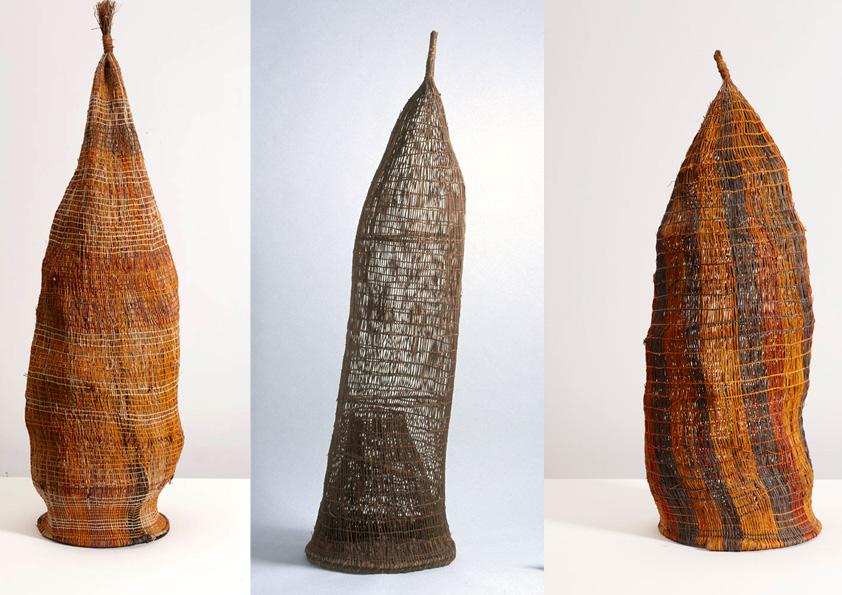
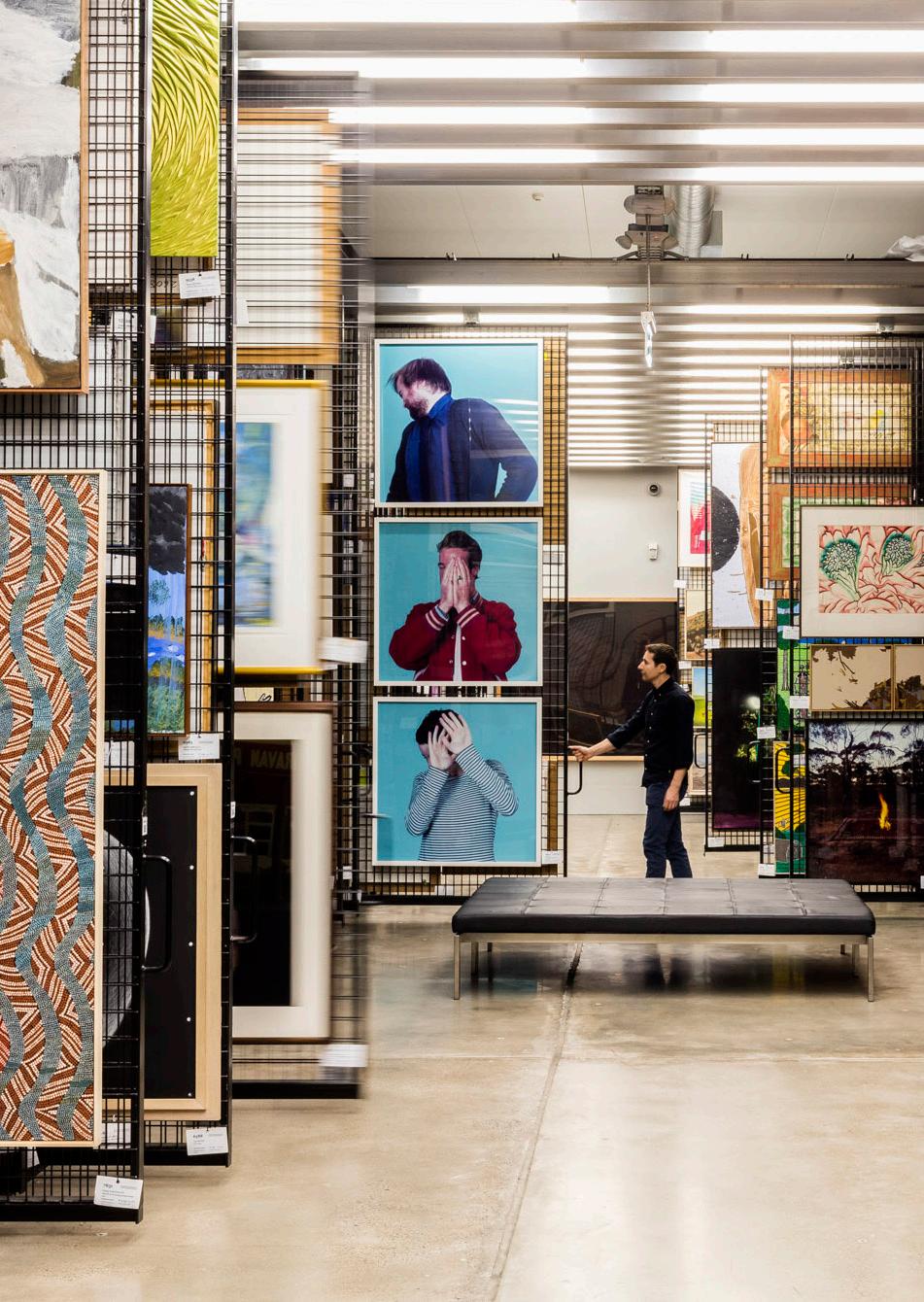
Caring for your collection
Follow these tips
In welcoming Artbank works into your space, follow these tips on looking after them for us;
• Advise any cleaning staff to take great care when cleaning areas around artworks.
• Contact your consultant if a work needs maintenance like dusting or cleaning.
• Please ensure the artworks remain untouched and left where they were installed.

• If you need the artworks moved – just call us! We will arrange this straight away for you.
• If you notice damage to any work let us know straight away so we can save the artwork.
Sign up to our Artbank newsletter
Tom Ferguson
Telephone: 1800 251 651
Get in touch with an Artbank Consultant today and help support the Australian contemporary artists of tomorrow!
